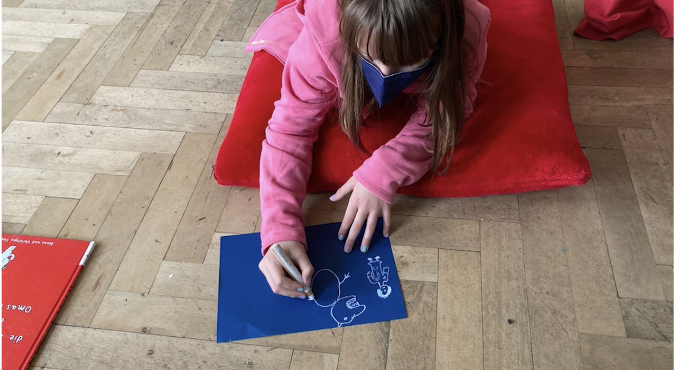Workshop 5
Implementation: what do we need?
– Upstream: ask students to draw the story their parents preferred as children
-upstream, having read with the students, the tale or tales. s/ legend. s that you wish to work
– A workspace. The room provided must be large enough and arranged in such a way as to accommodate all participants and allow freedom of movement, the workshop requiring a physical commitment.
The participants
The methodology is aimed at primary and sixth grade students, aged between 9 and 13. Ideally, the group should not exceed 30 students.
Speaker
School teacher, educator, theatre teacher
Objectives of this workshop
Strengthen the capacity for individual and collective reflection around a text.
discover that the same story can have different versions
learn to exchange a story (listening and restitution)
Time required
90-120 minutes
Implementation
The workshops use techniques of oral expression and debate around a theme related to a source text. They also put into practice, through body expression techniques, the questions theorized by students to allow a global understanding of the issues raised by the text.
Finality
At the end of the session, children will have:
Developed ability to work individually and in groups
realized that a story depends on who tells it
Work on listening and speaking in public
Strengthened their critical thinking by sharing and discussing symbolic themes present in their stories.
Upstream: ask students to draw the story that their parents preferred as children
1. Start session
The clap
In a circle, the children pass a clap to their neighbor. e (one claps in his hands) while making the circle. For the clap to pass, students must look each other in the eye before clapping their hands!
2. Narrative construction
From here, it is necessary to have chosen a working axis:
Or you decide to work on the writing of invention: you can however pre-select a theme to treat to frame the work of the students
Either you want to work on the adaptation of existing narratives: the themes dealt with in these narratives seem interesting to transpose into another environment or another era.
the class is divided into 3 or 4 groups. Each group is assigned:
a tale of the world (see appendices)
or
A tale/ legend you decided to work on with the goal of making an adaptation.


The group tries to identify the different stages of the story. The facilitator asks students to divide an A4 sheet into six boxes. In groups, students draw the different stages of the story in the six boxes. In the first box, they draw the. a hero.ïne. In the second, the place. In the third, the opponent. In the fourth, the adjuvant. In the fifth, the action. In the sixth, the end of the story. Thus, the six boxes correspond to six tables summarizing the different stages of the story.

3. Tables
construction of storyboards: students are then asked to construct their respective storyboards in order to present them to the rest of the class. Each story is divided into 3 tables:
the representation of the initial situation (place, characters)
the action (incorporates the disruptive element and the action of the characters)
the representation of the final situation
The spectator students then give feedback to the group that came by to say what they understood, ask questions about what they did not understand well, and express their opinion about what they liked and what they liked about the presentation. They have to explain why, both for what they liked and what they didn’t like. They are also invited to brainstorm ideas to improve the presentation of their peers and share them with them to help them progress.

4. Parents histories
Each child’s drawings of the stories they collected from their parents are displayed. We first let the class look at the drawings. Then we ask if some people recognize stories through the drawings. Students are asked to describe what they see on those who have not been recognized. Differences in representation are pointed out on drawings that illustrate the same story. Thus, one must be able to review each drawing, and thus have heard each student who will validate or invalidate a suggestion, and even tell the story to make it discover to his comrades if necessary.
5. End of the ritual
Clapping
The. a leader stands opposite the other members of the group in order to be seen by all. He/she positions his arms horizontally and will clap his hands above his head. The others must imitate him at his/her pace. Then, little by little, he.elle will accelerate until reaching applause.
